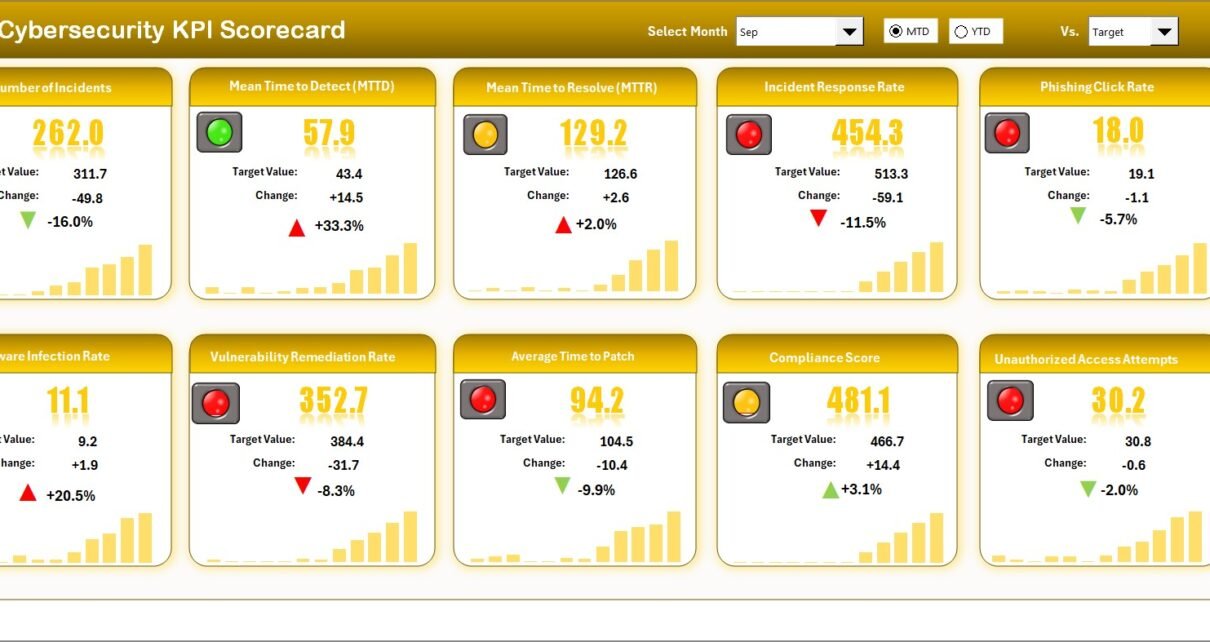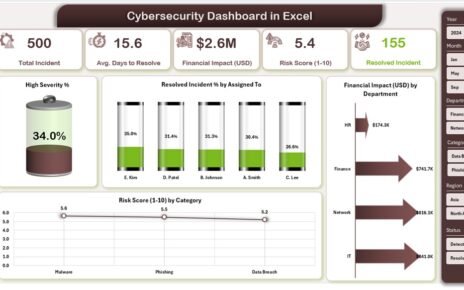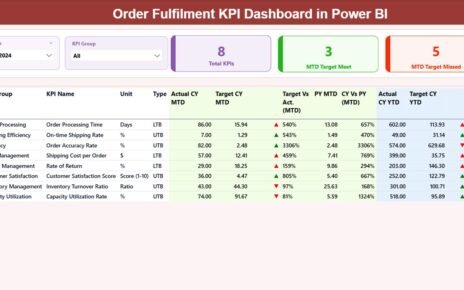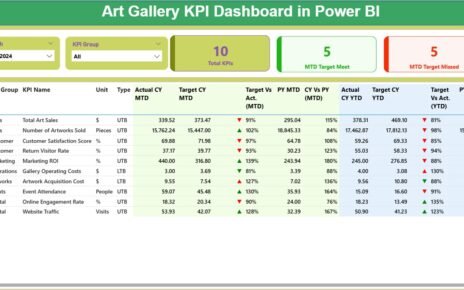In the modern digital era, cybersecurity is no longer optional — it is essential. Every organization, whether small or large, faces an increasing number of threats that can disrupt operations, compromise sensitive data, and damage reputations. To protect assets and ensure compliance, companies must track cybersecurity performance using structured and measurable indicators.
That’s where the Cybersecurity KPI Scorecard in Excel becomes an invaluable tool. This ready-to-use Excel template helps businesses measure, monitor, and improve their cybersecurity posture with precision. From tracking incident response times to monitoring system vulnerabilities, this scorecard allows organizations to take a proactive, data-driven approach to digital protection.
Click to Purchases Cybersecurity KPI Scorecard in Excel
What Is a Cybersecurity KPI Scorecard in Excel?
A Cybersecurity KPI Scorecard in Excel is a performance management tool that tracks the key performance indicators (KPIs) related to cybersecurity. It brings together essential metrics such as system uptime, number of detected threats, average resolution time, and compliance adherence — all within a single, easy-to-navigate Excel workbook.
Click to Purchases Cybersecurity KPI Scorecard in Excel
Built with simplicity and effectiveness in mind, this scorecard allows users to:
-
Evaluate their cybersecurity readiness at a glance
-
Compare actual performance against targets
-
Identify areas that need improvement
-
Maintain records of monthly and yearly performance trends
With a combination of dropdown selections, color-coded visuals, and automatic calculations, this Excel-based scorecard provides a complete view of your cybersecurity performance.
Key Features of the Cybersecurity KPI Scorecard in Excel
This KPI scorecard template is designed with four dedicated worksheets, each serving a unique purpose for comprehensive tracking and analysis.
1. Scorecard Sheet
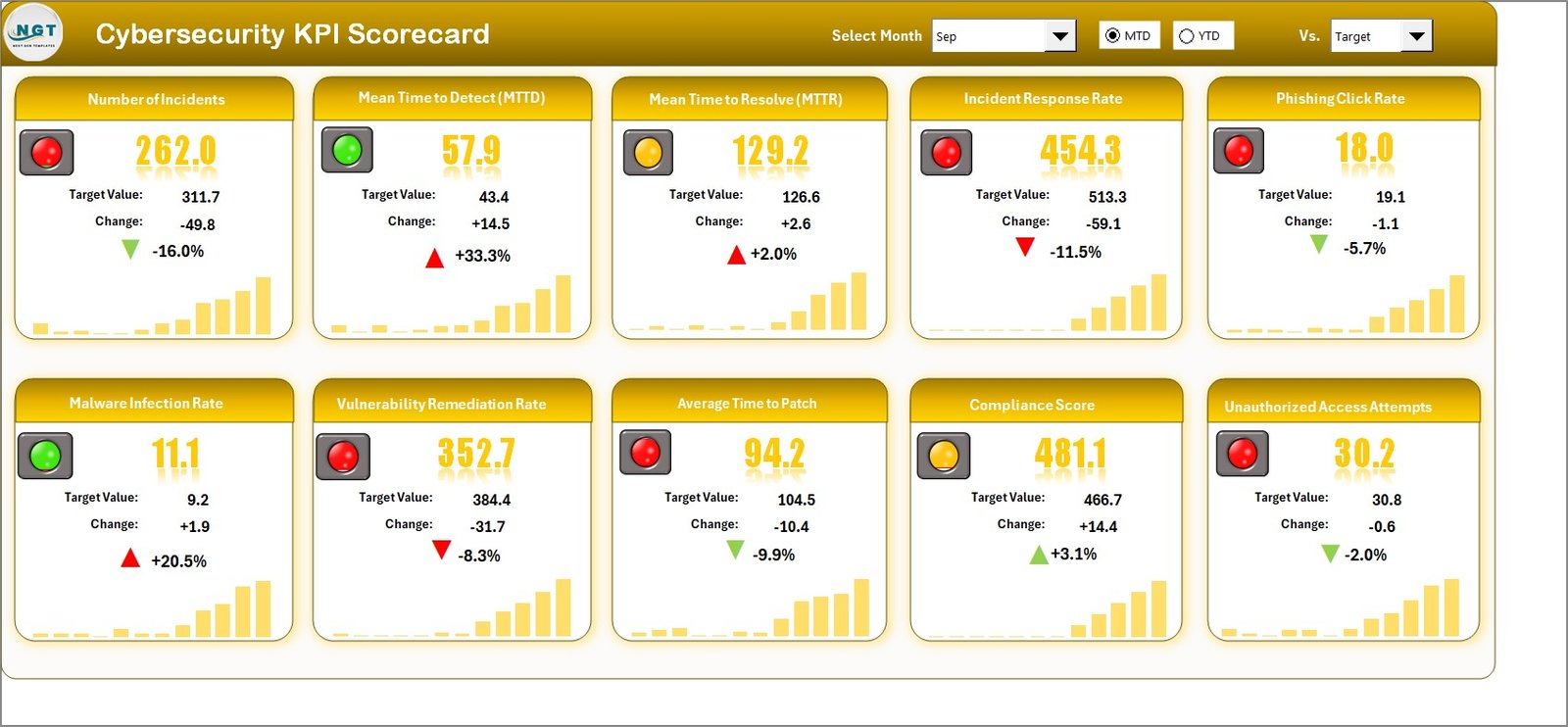
This is the main dashboard interface, where users can view all cybersecurity KPIs in one place.
Key highlights include:
-
Dropdown Menus: Select any month or view Month-to-Date (MTD) and Year-to-Date (YTD) performance.
-
Actual vs Target Comparison: See where your organization stands versus its goals.
-
Color-Coded Visuals: Conditional formatting displays green, yellow, or red indicators for instant clarity.
-
Comprehensive KPI Overview: Quickly assess MTD and YTD comparisons across multiple cybersecurity domains.
-
10 KPIs Visible at Once: Ensures a clear and uncluttered view for decision-making.
This sheet acts as your central command center for monitoring cybersecurity health metrics in real time.
2. KPI Trend Sheet
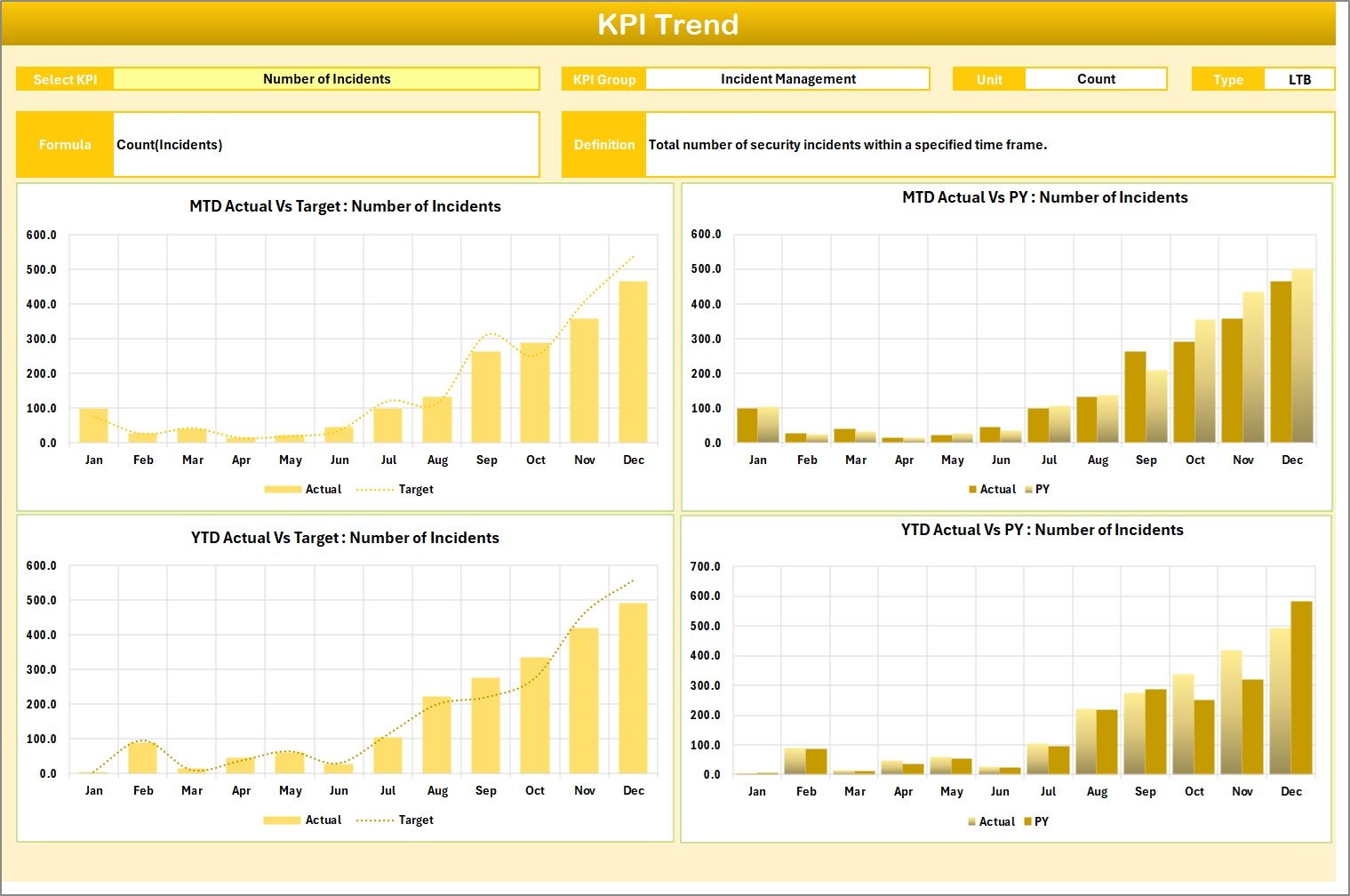
This sheet focuses on performance analysis over time.
Features include:
-
KPI Selection Dropdown (Cell C3): Choose any KPI to analyze trends.
-
Auto-Displayed Information: The sheet displays KPI Group, Unit, Type (UTB or LTB), Formula, and Definition.
-
Trend Charts: MTD and YTD trend charts for Actual, Target, and Previous Year (PY) data help visualize progress.
-
Comparative Insights: Users can easily identify whether performance is improving or deteriorating.
The KPI Trend sheet helps in understanding the direction and speed of cybersecurity performance — a crucial element in proactive threat management.
3. Input Data Sheet
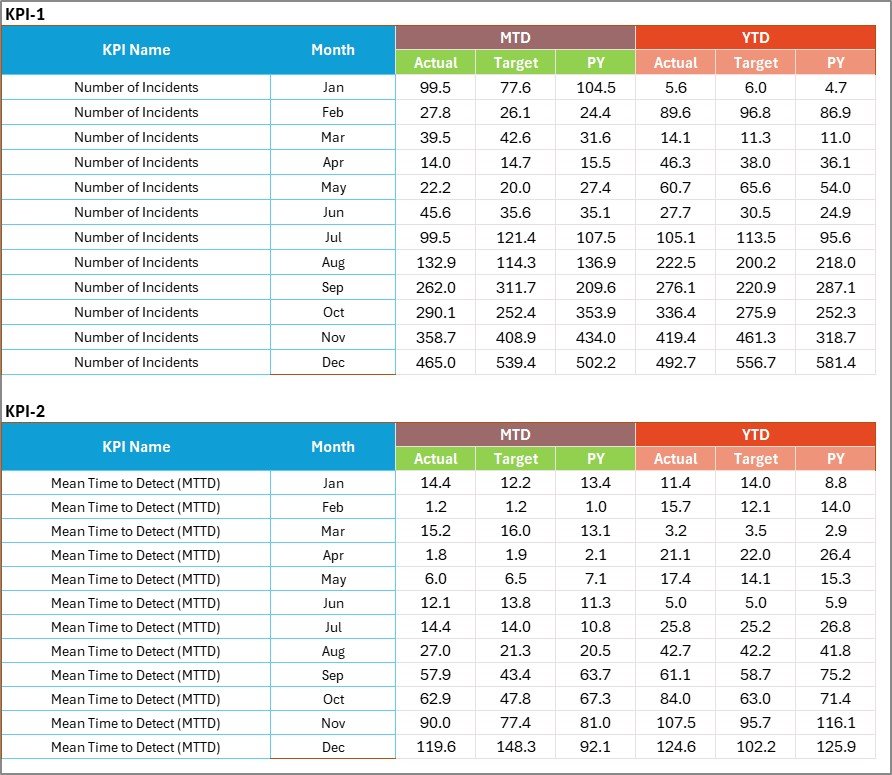
This sheet is where users record all raw data and updates.
Key features include:
-
Simple Data Entry: Enter actual values, targets, and related details for each KPI.
-
Flexibility: Update data monthly or quarterly to keep the scorecard accurate and up to date.
-
Automatic Calculations: The linked formulas update all dashboards instantly when data is refreshed.
This sheet acts as the data backbone of your entire scorecard.
4. KPI Definition Sheet

This tab serves as the knowledge reference for all KPIs.
Includes columns such as:
-
KPI Name
-
KPI Group
-
Unit of Measurement
-
Formula
-
KPI Definition
-
Type (Upper the Better or Lower the Better)
Having a clearly defined KPI sheet ensures everyone understands what each metric represents and how it contributes to cybersecurity improvement.
Why Organizations Need a Cybersecurity KPI Scorecard
Cybersecurity involves multiple moving parts — from network defense to compliance monitoring. Tracking performance manually across different spreadsheets often leads to errors, inefficiency, and missed insights.
A Cybersecurity KPI Scorecard bridges this gap by offering a structured way to measure performance. Let’s look at why this scorecard is indispensable:
-
Data-Driven Decisions: Enables leadership to act based on facts, not assumptions.
-
Early Threat Detection: Tracks anomalies before they escalate into full-blown incidents.
-
Accountability: Assigns responsibility and transparency to cybersecurity goals.
-
Compliance Support: Helps ensure regulatory requirements (like GDPR, ISO 27001, HIPAA) are met.
-
Efficiency Gains: Reduces manual analysis time through automated calculations.
Advantages of Cybersecurity KPI Scorecard in Excel
Using this Excel-based scorecard brings several powerful benefits to any organization aiming to strengthen its cybersecurity practices.
1. Centralized Monitoring
Track all cybersecurity KPIs in one organized Excel file. No need to manage multiple data sources.
2. Real-Time Insights
As soon as you update data, all metrics and charts refresh automatically — giving instant visibility.
3. Simple Yet Powerful Visualization
The use of conditional formatting, charts, and dropdowns allows for quick interpretation without complex tools.
4. Enhanced Accountability
Assign ownership to KPIs and track which department or individual manages each indicator.
5. Time and Cost Efficiency
No need for expensive software or complex BI tools — Excel provides a cost-effective, easy-to-maintain alternative.
6. Improved Compliance
Track and document performance for audits or internal reviews with ease.
7. Customization Flexibility
Add or remove KPIs, modify formulas, and adjust visuals based on your specific cybersecurity framework.
How to Use the Cybersecurity KPI Scorecard
Here’s a step-by-step guide to help you get started with the scorecard:
Step 1: Enter KPI Definitions
Go to the KPI Definition sheet and list all your cybersecurity KPIs along with their units, formulas, and types.
Step 2: Input Monthly Data
Record actual and target values for each KPI in the Input Data sheet. Be consistent with the format for accuracy.
Step 3: Select Month in Scorecard
Use the dropdown menu in the Scorecard sheet to select a month. The scorecard will instantly display updated MTD and YTD figures.
Step 4: Analyze Trends
Head to the KPI Trend sheet and choose a KPI from the dropdown (cell C3). Review the MTD and YTD charts to identify positive or negative trends.
Step 5: Review and Act
Use the color indicators (green for on target, red for missed target) to take timely actions for improvement.
Click to Purchases Cybersecurity KPI Scorecard in Excel
Best Practices for the Cybersecurity KPI Scorecard in Excel
To get the best results from your scorecard, follow these proven best practices:
✅ Define Clear KPI Ownership: Assign each KPI to a responsible team member.
✅ Update Data Regularly: Refresh actual and target values every month.
✅ Use Consistent Naming Conventions: Keep KPI names and groups consistent across all sheets.
✅ Set SMART Targets: Ensure each KPI target is Specific, Measurable, Achievable, Relevant, and Time-bound.
✅ Monitor Both MTD and YTD Performance: Helps in short-term and long-term analysis.
✅ Review KPI Definitions Annually: Update them based on new threats or regulatory changes.
✅ Backup Data Securely: Keep historical records for trend analysis and compliance audits.
Following these best practices ensures accuracy, reliability, and meaningful insights from your cybersecurity scorecard.
How the Scorecard Enhances Decision-Making
When it comes to cybersecurity, decisions must be fast, precise, and data-backed. This Excel-based scorecard allows leaders to identify critical patterns such as:
-
Which KPIs are consistently missing targets?
-
Are threats increasing or decreasing month over month?
-
Which teams or departments need more resources or training?
With automated calculations and visual indicators, decision-makers can instantly interpret performance and focus on the most pressing security issues.
Click to Purchases Cybersecurity KPI Scorecard in Excel
Integrating the Cybersecurity KPI Scorecard into Your Organization
Implementing this scorecard can significantly improve your organization’s cybersecurity governance. Here’s how you can integrate it:
-
Communicate the Objective: Inform all departments about the purpose and benefits of the scorecard.
-
Collect Data from Multiple Sources: Include data from firewalls, antivirus tools, SIEM systems, and compliance audits.
-
Customize KPIs: Adjust KPI definitions to align with your company’s cybersecurity strategy.
-
Automate Data Imports (Optional): Use Excel Power Query or VBA for automatic data updates.
-
Conduct Monthly Reviews: Discuss KPI trends and improvement actions in management meetings.
By embedding this tool into regular review cycles, cybersecurity performance becomes transparent, measurable, and actionable.
Conclusion
Cybersecurity is a constantly evolving battlefield, and staying one step ahead requires structured performance measurement. The Cybersecurity KPI Scorecard in Excel empowers organizations to transform scattered data into clear, actionable insights.
By using this scorecard, you can monitor key metrics, visualize trends, and ensure every department contributes to a stronger security posture. With its simplicity, flexibility, and analytical power, this Excel-based tool is your ally in building a safer digital environment.
Frequently Asked Questions (FAQs)
1. What is a Cybersecurity KPI Scorecard?
A Cybersecurity KPI Scorecard is a tool that tracks, measures, and visualizes cybersecurity performance indicators such as threat detection rate, system downtime, and compliance status.
2. How many KPIs should I include in the scorecard?
Ideally, track 10 to 15 core KPIs to maintain focus and avoid clutter. You can always expand later as your cybersecurity program matures.
3. Can I customize the scorecard for my organization?
Yes, you can modify KPI names, formulas, and targets according to your organization’s structure and goals.
4. Do I need advanced Excel skills to use it?
Not at all. The scorecard is designed for ease of use, with built-in dropdowns, formulas, and visual indicators.
5. How often should I update the scorecard?
You should update it monthly or quarterly to reflect the most recent cybersecurity performance.
6. Can I use this scorecard for audit or compliance reporting?
Yes. It helps document cybersecurity performance metrics that can be shared during internal audits or external compliance checks.
7. What is the difference between MTD and YTD in this scorecard?
MTD (Month-to-Date) shows performance for the selected month, while YTD (Year-to-Date) provides cumulative performance from the start of the year.
8. Is this template suitable for small businesses?
Absolutely. The scorecard is scalable and works well for small, medium, and large organizations.
Click to Purchases Cybersecurity KPI Scorecard in Excel
Visit our YouTube channel to learn step-by-step video tutorials
